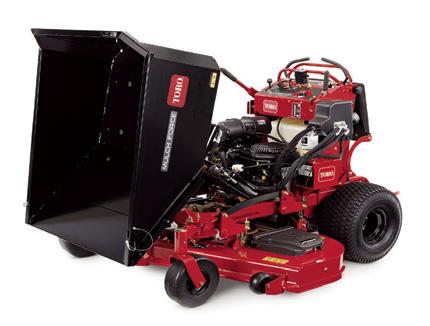






By Tom Castronovo Executive Editor/Publisher Gardener News
On April 15, 2024, the State of New Jersey Division of Fire Safety adopted the 2018 International Fire Code, New Jersey Edition. This provision becomes operative 12 months after the effective date of these rules, which is April 15, 2025.
This change will affect the use of combustible landscape materials or “mulch” in all applications with the exception of owner-occupied, one and two-family or attached single family dwellings used exclusively for dwelling purposes. Townhouses are

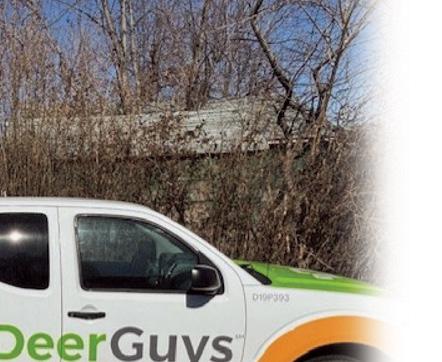


considered attached singlefamily homes.
Landscaping mulch has become the predominant choice for both residential and commercial ground cover. However, its use comes with certain risks, particularly during dry seasons.
“The regulations were adopted for the safety of residents, occupants of buildings, and first responders. Fires originating from ignited mulch have resulted in significant property damage, injuries, and deaths, and compelled regulators to include these provisions in the adoption of the 2018 International Fire Code,” said State Fire Marshal and Division of


(Cont. on Page 16)



Many garden situations have soils that drain poorly either due to the type of soil, or possibly soil compaction, or due to a high-water table, or proximity to a body of water such as a stream, river, lake or pond. While many plants are intolerant of these conditions, there are many plants that not only tolerate these conditions but can thrive.
Many trees in natural habitats grow in soils that are constantly moist or even waterlogged. One of the best trees for wet areas is the native red maple, Acer rubrum. Over the years, there have been many outstanding cultivar selections including Redointe® which is a relatively new introduction. It has an upright, broadly pyramidal habit, and like all selections of red maple has outstanding brilliant red fall color. Because of its outstanding ornamental attributes, it was awarded the Gold Medaal Award distinction by the Pennsylvania Horticultural Society. Both Red Sunset® and October Glory® have urban tolerance and are great as street trees.
Aptly named the river birch, Betula nigra is found in its natural habitats growing along the flood plain of streams and rivers. The river birch is one of the fastest growing of all trees. In its youth it has beautiful flaking bark with color tones

By Andrew Bunting Vice President of Horticulture
of cream, pink and brown. Heritage® is an outstanding selection for more northern climates. Northern Tribute® has superior cold hardiness, thriving in Zone 3, and Dura Heat® was selected for exceptional heat tolerance. ‘Little King’ has a more diminutive stature. At maturity it reached approximately 20 feet tall with an equal spread. It has all the ornamental attributes of Heritage® and Dura Heat®.
Hornbeam, also known as Musclewood, is a native tree that has been promoted in recent years for its urban toughness and tolerance of many conditions and soil types. Carpinus carolinana has silver sinuous trunks that become more ornamental with time. The fall color can vary from yellow to orange to red. Firespire® is an upright selection reaching 20 feet tall and a spread of 10 feet, with exceptional
red fall color. Because of their size, the hornbeams are often used as street trees under power lines.
Growing in the swamps of the Southern United States, the baldcypress is one of the best trees for extremely saturated soils. Taxodium distichum is a deciduous conifer with very fine needles that turn a brilliant coppery orange before they are shed in the fall. Reaching nearly 100 feet tall, the habit is fairly upright before it begins to broaden with age. Shawnee Brave™ is an excellent upright oval selection. Lindsey’s Skyward™ is more diminutive in stature, reaching only 25 feet tall at maturity with a more pyramidal habit. Closely related is the pond cypress, Taxodium ascendens Debonair® is a selection of the Morris Arboretum for its broad oval habit and vibrant coppery-orange fall color. Another related species is
the Chinese counterpart, the dawn redwood, Metasequoia glyptostroboides. Like the baldcypress and pond cypress, it is a deciduous conifer with bronze fall color. The dawn redwood is very fast growing. In its youth it can grow up to six feet a year. It quickly matures into a tree with a broad pyramidal habit. Soul Fire® is a new selection with great golden yellow needles throughout the summer. Some other cultivars come out yellow but fade to green by mid-summer. While almost all magnolias like well-drained soil, there is an exception. The sweetbay magnolia, Magnolia virginiana var. australis occurs in wet areas along the coast plain from Massachusetts south to Florida and east to Louisiana. This tree can be grown as a single trunked tree, or it is often sold as clump forming with multiple trunks. At maturity, it will
reach 30-40’ tall with dark green oval leaves with a silvery underside which is revealed when the wind blows. In mid-spring, starlike flowers emerge. They have an amazing lemony fragrance. Flowering will continue sporadically into the late summer. There are several exceptional selections including ‘Santa Rosa’, ‘Satellite’, ‘Henry Hicks’ and ‘Green Shadow’.
Editor’s Note: Andrew Bunting is Vice President of Horticulture for the Pennsylvania Horticultural Society. He is one of the most recognized horticulturists in the Philadelphia, Pa., region and a highly regarded colleague in the world of professional horticulture. Bunting has amassed a plethora of awards, including the American Public Gardens Association Professional Citation, Chanticleer Scholarship in Professional Development, Delaware Center for Horticulture’s Marion Marsh Award, and the Certificate of Merit from the Pennsylvania Horticultural Society. In addition, Bunting has lectured extensively throughout North America and Europe, and participated in plant expeditions throughout Asia and Africa. Learn more at https://phsonline.org/team/ andrew-bunting
The Dr. Benjamin C. Blackburn Scholarship for 2025 Offered for County College of Morris Students in the Horticulture / Landscape Program Applications must be postmarked by April 11, 2025
The Blackburn Scholarship was established by the Friends of The Frelinghuysen Arboretum (Friends) in 1979 to honor the memory of the late Dr. Benjamin C. Blackburn, whose professional horticultural expertise and support was of great help to the Arboretum and the Friends during their early years. This scholarship is funded by the Friends’ Blackburn Scholarship Event held in early February.
The Friends’ Board of Trustees is pleased to announce that they have again selected the County College of Morris (CCM) as their
partner through which to award the Benjamin C. Blackburn Scholarship. One or more CCM students, enrolled in the Department of Landscape and Horticulture Technology will be chosen to receive scholarship money totaling up to $3,000.00.
The Friends are excited about working with CCM and their students. These students are pursuing careers, or in some cases second careers, in the field of horticulture. The program is well known for its success stories, with many graduates going on to complete four-year
degrees at other universities. This partnership is a logical step in the growing relationship with CCM as many students serve as interns at the Frelinghuysen Arboretum and as volunteers at the Friends’ Annual Plant Sale.
In addition to enrollment in the Horticulture/ Landscape program at County College of Morris, the scholarship recipients must also be New Jersey residents with a minimum 3.0 GPA in order to apply.
Learn more at https://www.arboretumfriends. org
We’ve all heard the old saying about April showers and May flowers, and many of you have heard the “Dad Joke” about what Mayflowers bring (for those who don’t speak Dad, the answer is “pilgrims.”)
But there’s a reason for most old sayings lasting long enough to be considered old, and the one on flowers is no exception.
Some of these sayings are more like mnemonic devices and they explain, instruct, or warn of something… “Lefty loosey, righty tighty,” for screws and bolts. “A Rat In Tom’s House Might Eat Tom’s Ice Cream” for a way to remember how to spell arithmetic. Many of us learned in school the order of planets moving out from the sun as “My Very Excited Mother Just Sat Upon Needles and Pins,” or Mercury, Venus, Earth, Mars, Jupiter, Saturn, Uranus, Neptune, and Pluto. (This, of course, was before Pluto’s recent demotion.)
And of course, this wisdom from 1986, “Never leave your wingman.”
Some of these sayings like “April Showers” are from poems or proverbs. In fact, the original “Sweet April showers/Do spring

By Joe Atchison III Assistant Secretary of Agriculture
May flowers” was first written as part of a poem in 1610 and evolved into the proverb, “March winds and April showers bring forth May flowers,” which was recorded in 1886, exactly 100 years before Jester warned Maverick about his wingman.
These sayings exist – and persist – because they are true… most of the time. April in New Jersey sees the most average rainfall throughout the year, according to WeatherSpark statistics. That means April is a great time to sow seeds and seedlings that are hardy.
Oddly, the whole “April showers” reference would seem to be a mostly North American and Western European phenomenon, as worldwide, June is the rainiest month, due in part to much of the world
experiencing the tropical-area rainy seasons that result from warm, moist air moving over large land masses like South America and Asia.
You’ll find it pays to keep up on the rainfall and other weather information for the area where you’ll plant, as well as having your soil tested (Rutgers Master Gardeners can help with this) and learning about any other natural or geological aspects of your home county that could impact plant growth and health.
Of course, what you plant and when depends on where in New Jersey you are located. The Old Farmer’s Almanac has a great planting calendar that shows recommended dates for planting in many areas throughout the Garden State. Once they are planted, the plants
FAMILY SIZE, SERVES 4 PORTION SIZE: 6 oz
12 oz. baby spinach
4 oz goat cheese, crumbled
½ cup pumpkin seeds
½ cup dried cranberries
cracked black pepper to taste
Balsamic Vinaigrette:
1 Tbsp Dijon mustard
3 Tbsp. balsamic vinegar
5 Tbsp extra virgin olive oil
¼ tsp salt
¼ tsp. pepper
1
2
will be nourished by April rains and bloom nicely through May.
An example of that planning tool can be found at: www. almanac.com/gardening/ planting-calendar/NJ/Camden
By searching through all the varied conditions that can exist throughout New Jersey’s 21 counties, you can find the proper tips to make sure that the plants you’re thinking of using can be most successful as we move from April to May.
But April is also the month of Arbor Day, which began in the U.S. in Nebraska in 1872, when J. Sterling Morton was surprised by the lack of trees in the state compared to locations along the East Coast. That year on April 10, one million trees were planted in Nebraska. The idea caught on and is now observed
throughout the country. This year, Arbor Day is on April 25, so be sure to visit your favorite nursery or garden center and pick up a sapling or semi-mature tree to add to your landscape. Finally, April is now widely known as the month of Earth Day, a much newer concept having been originally observed on April 22, 1970. Earth Day demonstrates support for environmental protection and can be observed in many ways, from attending events, listening to teach-in lessons, to cleaning dirtied waterways and planting in your community or at your home.
So, when there are gray, depressing days in April, shake them off and smile at the notion that more colorful, sunny days are ahead in May, thanks to agriculture!
Editor’s Note: Joe Atchison III is the New Jersey Assistant Secretary of Agriculture. Atchison is also the Director of the Division of Marketing and Development for the New Jersey Department of Agriculture. He can be reached at (609) 292-3976.
3 F U N F A C T !
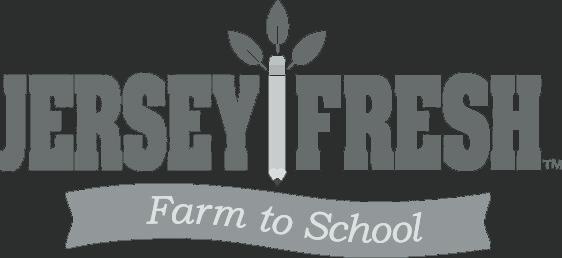


Place spinach, goat cheese, cranberries, pumpkin seeds to a mixing bowl
https://www.nj.gov/agriculture/farmtoschool Salad:
Did you know that spinach is a powerhouse of nutrients? Just one cup of raw spinach provides about 56% of your daily vitamin A needs and 15% of your daily vitamin C needs Talk about a leafy green superhero!
In a separate bowl, combine the Dijon, balsamic vinegar, olive oil, salt, & pepper Whisk ingredients together until fully incorporated. Dressing will be smooth and velvety
Drizzle dressing over greens. Season to taste with fresh ground black pepper

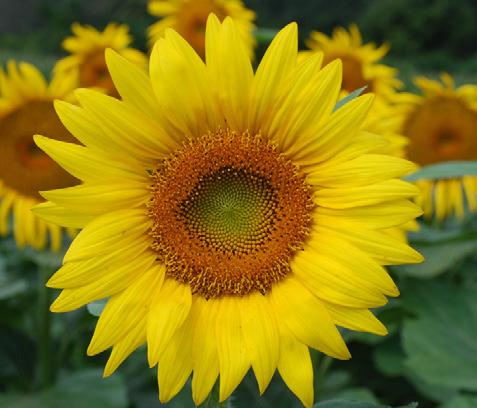





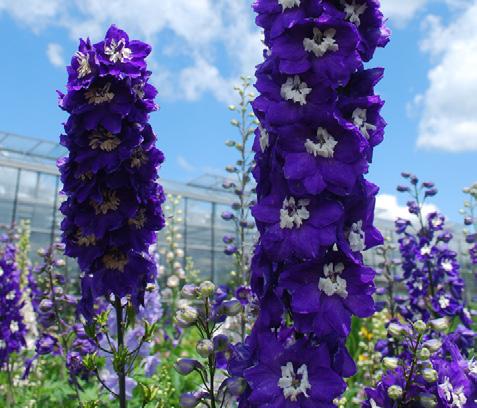



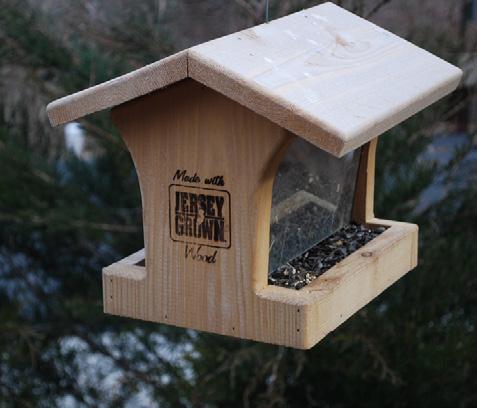


Atlantic County
Phone: 609-625-0056
Bergen County Phone: 201-336-6780
Burlington County Phone: 609-265-5050
Camden County Phone: 856 216 7130
Cape May County Phone: 609-465-5115
Cumberland County Phone: 856-451-2800
Essex County Phone: 973-228-2210
Gloucester County Phone: 856-224-8040
Hudson County Phone: 201-915-1399
Hunterdon County Phone: 908-788-1339
Mercer County Phone: 609-989-6830
Middlesex County
Phone: 732-398-5260
Monmouth County Phone: 732-431-7260
Morris County Phone: 973-285-8300
Ocean County Phone:732-349-1246
Passaic County Phone: 973-305-5740
Salem County Phone: 856-769-0090
Somerset County Phone: 908-526-6293
Sussex County Phone: 973-948-3040
Union County Phone: 908-654-9854
Warren County Phone: 908-475-6505



As New Jersey gardeners enjoy the spring season, excitement abounds for new landscape plantings. Embracing ecology, many gardeners increasingly wonder how they can best support pollinators while creating beautiful landscapes. Native herbaceous perennials appropriately get lots of attention as their blooms provide essential nectar and pollen for insects, and beautiful displays for gardeners to enjoy through the seasons.
Spring-blooming native trees also offer key benefits to pollinators. While some Garden State residents might associate spring tree pollen with allergy season, ecologically, tree pollen is very important! It’s often the first food source available to pollinating insects. When tree foliage emerges, larval butterflies and moths benefit from this food source. Incorporating native flowering trees into your landscape is a fantastic way to contribute to the ecological balance in your yard, and it’s the perfect opportunity to add spring color to your home and garden with the right selections.
Eastern Redbud (Cercis canadensis) is a lovely small to medium-sized tree that can tolerate dry sites. Flowers emerge early, providing spring color and nectar for pollinators. After bloom, Redbud trees feature heartshaped leaves ranging from bright chartreuse through reddish purple hues, or even variegated foliage depending on the variety. Many Redbud cultivars are available from local nurseries, offering bloom colors from deep purple or magenta through light pastel pink to white. When learning to identify trees, a go-to acronym to remember which trees have opposite branching patterns is MADHORSE: Maple, Ash, Dogwood, and Horse Chestnut.
Alternate-leaf dogwood (Cornus alternifolia), as the name suggests, is a notable exception. Also called Pagoda dogwood for its tiered branching structure, Alternateleaf dogwood has tiny flowers important to native pollinators. While lacking the showy bracts the Flowering dogwood (Cornus florida) is known for, the petite cream-colored flowers, burgundyred autumn foliage, and interesting branch patterns make Alternateleaf dogwood a superb ecological landscape choice.
Spring is truly on the way when the Red Maple (Acer rubrum) buds begin to open. The emerging flowers on these stately trees may be hard to recognize from ground level, but even from a distance their bright red hues stand out against the gray bark. Closer examination, if a branch is within reach, reveals a delicately beautiful flower rich with bright yellow pollen; red maples are one of the first primary food sources for multiple species of native bees. Perhaps best known, and named, for their fall foliage colors, red maples offer a stunning autumn display of deep red, orange, and golden foliage depending on the variety and growing conditions.
A strong and hearty tree, American Hornbeam (Carpinus caroliniana) is also called Musclewood in reference to its dense wood and bark, which resemble tensed muscles. The flowers emerge on female trees in the spring as small, white to pale yellow blooms that hang in tiny clusters. While the delicate flowers are lovely, from a landscape interest perspective, the deep blue-gray toned bark is the real attraction! American Hornbeam grows well in partial to full shade and appreciates somewhat wet soils, making this a good choice to plant in areas with limited sun or challenging
drainage. This tree is a host species for multiple types of butterflies and moths whose larvae thrive on the foliage.
For those interested in edible landscaping, the Pawpaw (Asimina triloba) is a great choice. A small to medium-sized tree, Pawpaws have beautiful blue-green foliage during the growing season that transitions to a stunning bright yellow-golden hue in the fall. The edible fruit, which is the largest fruit native to North America, is often described as something akin to a papaya, mango, or banana! It may very well be the most interesting fruit you’ve never had: a short shelflife and tendency to bruise make tender pawpaw fruits a challenge for commercial production. If you’re curious, but not yet ready to plant your own trees (two or more are needed for pollination and fruit production), visit local farmers markets during the month of September and ask if the vendors have pawpaw fruits available.
Interested in seeing flowering trees in bloom before you make your own landscape selections? Rutgers Gardens, the botanic garden of Rutgers, the State University of New Jersey, features hundreds of flowering trees with an incredible spring color display in North Brunswick, NJ. Now is the time to visit! Free and open to the public, Rutgers Gardens welcomes visitors Tuesday – Sunday and, together with Rutgers Cooperative Extension, provides educational opportunities year-round. To learn more, and to purchase native plants, join Rutgers Gardens and Rutgers Cooperative Extension educators at Rutgers Day (Ag Field Day) on the Cook campus of Rutgers – New Brunswick! This free annual event will offer fun for the whole family from 10am – 4pm on Saturday, April 26, 2025.
Ming-Yi Chou, turfgrass pathologist in the Department of Plant Biology, has won the 2024–2025 Merle V. Adams Award, which is presented to an assistant extension specialist faculty for excellence in extension and research. His extension program focuses on evaluating and
developing efficient cool season turfgrass disease management measures.
Since it was first presented in 1987, the Merle V. Adams Award has been given each year in honor of the long-term chair of the Agricultural and Resource Management Department and his
dedication to the specialists and faculty he served.
Chou, whose tenure began in April 2023, is continuing to build Rutgers impactful turfgrass pathology program established by his predecessor, retired extension specialist Bruce Clarke, and working in collaboration with
internal partners, such as the Plant Diagnostic Laboratory, Center for Turfgrass Science and the Department of Plant Biology, and external stakeholders in the Northeast and beyond. He currently directs the largest turfgrass disease control product evaluation program of its kind in the U.S.
Joel Flagler, Rutgers Cooperative Extension (RCE) Agriculture and Natural Resources agent in Bergen County and professor in the Department of Plant Biology, retires effective March 1. Flagler, whose Rutgers journey began as a student – he holds a degree in horticulture from Cook College in 1974 – leaves a deep legacy at his alma mater. He entered the tenure stream as an RCE agriculture and natural resources agent for Bergen County in 1988 and, in 1990, Flagler became County Extension Department Head.
If asked, Flagler would say that one of his most noteworthy accomplishments was to dispel the myth that Bergen County had ‘no agriculture left.’ The old metrics of counting the number of farms showed a steady decline in farm acreage as farm families sold out to developers. “Agriculture is much more than the number of farms or pounds of tomatoes or number of cows and chickens,” says Flagler. And in Bergen County, he recognized a huge ornamental horticulture industry, including landscape contractors, arborists and urban foresters, garden centers, nurseries and turf managers.
The Bergen County Department of Parks boasts more than 10,000 acres in parklands and preserves, all of which this contributes to the larger agricultural profile, as it all involves management of trees, shrubs, turfgrass and more. Flagler brokered agreements between the Board of Agriculture and the Landscape Contractors Association and saw the Board of Agriculture include landscape contractors in its leadership, which they’ve now done for decades. He helped foster a new recognition of agriculture in all its many faces, including urban forestry, landscape contracting, nursery management, lawn care, sports turf, corporate and school campuses, community and home gardens, and also horticultural therapy.
Today, Bergen is recognized as having some of the finest nurseries and parks in the state, with significant revenues and economic impacts, shares Flagler. His research in the 90s showed that the ornamental horticulture aspects of agriculture more than equaled the production of fruits and vegetables, and that drew attention from the NJ Secretary of Agriculture. That research was done in partnership with key professional associations, including New Jersey Turfgrass Association, NJ Landscape Contractors Association and the NJ Nursery and Landscape Association.
For decades, Flagler has provided training and continuing education for professionals in landscape contracting, tree and turf maintenance, and serving many hundreds working in Bergen County’s ornamentals industry. Part of his responsibilities also included providing training for employees of Bergen County Parks Department. In Bergen County, professionals have learned to use IPM tactics, which involve maximizing plant resistance through proper selection and cultural practices, while relying less on chemical pesticides to minimize pest problems.
As a result, professionals and home gardeners do more soil testing and apply fewer applications of chemicals and unnecessary fertilizer and lime. Flagler has also coordinated and delivered the Rutgers Master Gardener program, which started in Bergen County in 1984 by his predecessor, Dr. Ralph Pearson. He has trained thousands of laypersons who volunteer in county parks, take leadership roles in community shade tree and environmental organizations, disseminate Rutgers information at Earth Day events and environmental
fairs and more. The Master Gardener program is now found in nearly all NJ counties, owing to the successes demonstrated in Bergen County.
A registered horticultural therapist, Flagler has put a unique understanding of the relationship of plants and humans to work by developing the first curricula in horticultural therapy (HT) in the Department of Plant Biology at Rutgers.
He has always believed that no one should be denied the benefits of working with plants. He has worked with the disability community, housing authorities, prisons, and veterans’ facilities and helped to re-connect people with plants and nature. It has always been his belief that successes with plants can lead to other successes in our lives; and everyone can have these successes on some level.
Rutgers is one of just a handful of universities that has a fully accredited certificate program in Horticultural Therapy, and it has served as a model for programs all over the world. In October 2024, Flagler addressed the Canadian Horticultural Therapy Association national conference and serves as a mentor for many students in the U.S. and Canada.
“Growing food is a common objective in many Horticultural Therapy programs. It is empowering for individuals and families to eat what they have grown, and to share produce with those in need. The use of raised beds and specialized growing containers is promoted widely for best yields and to accommodate individuals who use wheelchairs,” said Flagler.
He has also created more than 40 HT programs in New Jersey, which were designed to serve veterans, post-stroke seniors, developmentally disabled individuals, correctional youth and other special needs populations. The settings are for healing, rehabilitation and training, and always focus on people growing plants and plants “growing” people.
The seeds of a life in horticulture and appreciating the restorative power of plants were sown some 55 years ago when Flagler was in his first year at Rutgers in 1970. He is quick to give credit to Rutgers and to recognize how Rutgers saw in him things he did not see himself—like how to connect his passion for agriculture with his passion for psychology. The ongoing encouragement he received as an undergraduate student prepared him for success at Yale University, where he earned a master’s degree in forestry on a full fellowship.
At Rutgers, his key mentors and advisors were Dr. Jim Applegate, Dr. Lenny Wolgast, and advisor Tom Concannon. “I am forever grateful to them, and for the total environment of encouragement on the Cook campus,” said Flagler.
In his 38-year career, Flagler has won numerous awards for his life’s work in horticulture. Among the most meaningful is the 2022 Distinguished Service Award by the New Jersey Nursery and Landscape Association, which recognizes the contributions of an individual who has given their time and resources to support and grow the horticulture industry in New Jersey.
He’s also very proud to have been a two-time national winner of the Communications awards given by the National Association of County Agriculture Agents. Flagler has also twice received the Extension Award for Diversity, which recognizes his work for underserved audiences and the disability community.



By Andy Lagana Chef
Greetings Gardener News readers. We are coming into the season of spring, a time that represents new beginnings, renewal, and hope. For me, this past winter seemed eternal, but fortunately we are in for longer days, warmer temps, and greater possibilities in the kitchen.
One of my favorite dishes at this time of year is Herb Roasted Lamb, which is best served as a main course for a special occasion - like Easter, a weekend family gathering, or when you want to impress guests due to its richness.
For ingredients, you will need 4 to 5 pounds of boneless leg of lamb trimming and tied, 12 large peeled garlic cloves, 1 tbsp. of chopped fresh rosemary, Kosher salt to taste, fresh cracked pepper to taste, 2 tbsp. unsalted butter, 4 to 5 pounds small unpeeled Yukon Gold potatoes, and 2 tbsp. extra virgin olive oil.
Leg of lamb is considered an excellent cut for herb roasted lamb because it’s a large, relatively lean muscle that benefits greatly from slow roasting with herbs, allowing the flavors to penetrate deeply while keeping the meat tender and juicy. The bone in a leg of lamb also helps to insulate the meat, contributing to even cooking and rich flavor. Due to its size and muscle structure, it is best cooked at a low temperature for a long time, which is perfect for allowing herbs to infuse the meat fully. Start by preheating the oven to 450° F. Place the
oven rack in the lower third of the oven so that the lamb will sit in the middle. Add the garlic in the bowl of a food processor fitted with the steel blade. Then, add the rosemary, 1 tbsp. salt, 1 tsp. pepper, and butter. Process until the garlic and rosemary are finely minced. Thoroughly coat the top and sides of the lamb with the rosemary mixture. Allow it to sit at room temperature for 30 minutes to 1 hour.
Toss the potatoes and remaining unpeeled garlic in a bowl with the olive oil and sprinkle with salt. Place in the bottom of a large roasting pan, and then place the lamb on top of the potatoes. Roast for 20 minutes. Turn the heat down to 350° F and roast for another 1 to 1 1/4 hours until a meat thermometer registers 130 to 135° F for mediumrare. Place the lamb on a cutting board, cover with aluminum foil, and allow it to rest for 15 minutes. Slice and serve with the potatoes.
As a side dish, a Strawberry Arugula Salad is always a hit with dinner guests. Apart from being a delicious mix of flavors, this nutritious fruit contains antioxidants which support your immune system and may lower your chances of getting sick. They may also help curb inflammation, lower your blood pressure and guard against health conditions like high cholesterol, cancer, heart disease, stroke, and diabetes. A wonder fruit for sure.
Set aside 1 cup chopped pecans, 2 tbsp. rice vinegar, 2 tsp. honey, 1 tsp. Dijon mustard, black pepper to
taste, ½ tsp. Kosher salt, ¼ cup extra virgin olive oil, 1 small thinly sliced shallot, 1 lb. of strawberries - hulled and quartered, 1 5-oz. pack of baby arugula, ½ cup of crumbled feta cheese and ½ cup fresh torn mint leaves. Preheat the oven to 350º F. Spread the pecans on a baking sheet and toast for 5 to 6 minutes, until they darken a shade or two and smell nutty. Let them cool completely. For the dressing, whisk together the vinegar, honey, mustard, salt, and a few grinds of pepper in a large salad bowl. Then, add in the olive oil and whisk the mixture until smooth. Add the shallot and strawberries, and toss to coat with the dressing. Add the arugula, feta, mint, and pecans and toss to coat everything with the dressing. Season with salt and pepper.
For a wine pairing, a bold red wine with a bit of age on it - like a Nebbiolobased Barolo - is a perfect selection. Nebbiolo is an Italian red wine grape variety predominantly associated with its native Piedmont region. It is thought to derive its name from the Italian nebbia or Piedmontese nebia, meaning ‘fog’. During the October harvest, a deep fog sets into the Langhe where many Nebbiolo vineyards are located.
And finally, you have an almost limitless choice of desserts which can be served post meal. Fruit based options such as apple berry crumble or a plum tart will make a wonderful addition. Enjoy!
visit www.CSResort.com.
The Northeast Dairy Business Innovation (NE-DBIC) announces a $1.1 million investment in regional dairy processing through the Dairy Co-Packing Grant. This funding supports the development of new and expanded co-packing capabilities for processors, ultimately leading to more dairy products for consumers across the region.
The Dairy Co-Packing grants is open to applicants in 11 Northeast states: Connecticut, Delaware, Maine, Massachusetts, Maryland, New Hampshire, New Jersey, New York, Pennsylvania, Rhode Island, and Vermont. Eligible applicants include:
• Dairy processors who are starting new co-packing partnerships.
• Dairy processors with existing co-packing services who want to scale up, add new products, or expand partnerships.
• Dairy brands that use or plan to use co-packing services.
Funding will support training and technical assistance for co-packing production. Funds may also be used for specialized dairy equipment, marketing and branding services, and more. To see specific requirements and the full list of what this grant can fund, visit the grant webpage: https://nedairyinnovation.com/processorcopacking-startup-grant/
Award amounts will range from $15,000 to $150,000, with a 25% in-kind and/or cash match. Approximately $1.1 million in total funds are available. Applications are open from February 11 through April 10 at 2:00 pm ET.
The NE-DBIC’s investment and project strategy promotes innovation and resiliency for regional production of dairy products across an 11-state Northeast region. Hosted by the Vermont Agency of Agriculture, Food and Markets, the NE-DBIC is funded through the USDA-AMS.
For more information on NE-DBIC, visit: https:// nedairyinnovation.com/
National Arbor Day is Friday, April 25, 2025
Help celebrate by planting a native tree.
Earth Day is Tuesday, April 22, 2025
Help celebrate by contributing to the health of our planet.
What native flower looks like five red and yellow doves feeding in a circle? It’s wild columbine, Aquilegia canadensis!
Wild columbines have unique nodding flowers composed of five tubular petals with bright red, long spurs, red bodies, and bright yellow flaring open ends which face sideways or more often downwards. These tubular petals represent the five feeding/ drinking doves arranged in a circle. Interspersed between the “five doves” are five broad red sepals with slightly reflexed tips which are also frequently bright yellow. There are about 20 extended, bright yellow stamens in each flower, a sheath of short staminodes, and 5-7 elongated central pistils, each with a slender superior ovary. The flowers are 1-2 inches long and start to appear at the end of April.
The generic name Aquilegia is Latin for eagle’s claws; the curved extended spurs resemble eagle’s claws. The common name columbine is from the Latin “columba” or dove. The plant ranges from South-Eastern Canada to Eastern and Southern US. In NJ it is found in almost all our counties.
There is an old saying that good things come in three. Supposedly, it stems from an ancient belief that three of something is complete and ideal. Hence, ‘third time is the charm’ and should you find a Genie, you will be the beneficiary of three wishes!
Even in the world of gardening, arranging plants in groups of three makes them look more natural. One plant that certainly embodies the concept of three is the genus Trillium! Commonly called Wakerobin or Toadshade depending on whether the flower has a floral stem or is sessile, these attractive April bloomers add a beautiful touch to the woodland garden!
Trillium is a relatively small genus, containing around 50 species native to mostly North America, although five species are native to Asia. Originally placed in the Lily Family or Liliaceae, it is currently a member of the Bunchflower Family or Melanthiaceae. The genus name was first penned in 1753 by the Swedish botanist Carl Linnaeus (1707-1778), who also placed it in the Liliaceae. The name comes from the Greek root of Tri for three and Līlium in recognition of its original family!
All Trillium species grow from

Wild columbine is a stunning spring flower. Several years ago, I took a particularly spectacular 1½ foot tall, one-foot-wide, choice specimen, covered with flowers, to a garden club meeting; the plant had a $20 price tag which for the time was a substantial amount. An older lady asked me if the sign said $20 or $200. I should have said $200 or perhaps $2,000.
In nature, mature wild columbines are six inches to a maximum of about three feet tall. The attractive, delicate compound leaves are fern-like and composed of numerous rounded leaflets. The flowers in the wild range from bright red to dull red to pink. Make sure your provider has the color you really like. Cultivars ‘Corbett’ and ‘Nana’ have solid yellow flowers. By early autumn the

By Hubert Ling Horticulture Chair
seed capsules, each with 5-7 tan seed pods, will split open to release small black seeds.
In NJ, wild columbine is found naturally on hillsides, old rocky walls, rocky or sandy soils, and in full sun or partial shade. They prefer slightly acid to moderately basic, welldrained soil and compete well in dry rocky areas since they are drought resistant. This trait is probably due to the presence of a short, thick underground stem termed a caudex which has tough fibrous roots. Plants in deep shade tend to be very short while plants with more sun and deep rich soil are much larger but tend to fade out more quickly. Plants are expected to live 3-5 years, but self-sowing is common if conditions are favorable.
Wild columbines are
propagated by seed which need a cool, moist, overwintering period to germinate. Do not start thousands of seedlings crammed into a single seedling flat. If this is discovered by leaf mining moths, you may have a zero-survival rate. Instead place about a dozen seeds in six or seven widely separated pots. Hopefully, survival will be good and your seedlings will mature to become more resistant to leaf miners.
Wild columbines are an important member of the NJ ecosystem. The nectar, which is located at the end of the long spurs, is utilized by hummingbirds, long-tongued bumblebees, and hawk moths. Short-tongued bumblebees may simply bore a hole in the side of the spurs and act as nectar thieves. Bees may also
By Bruce Crawford Horticultural Manager
a slowly spreading underground rhizome or horizontal stem, from which a stalk or scape emerges as early as mid-March in NJ. At the tip of the scape are three large bracts that resemble leaves and do, in fact, carry on the photosynthetic function of true leaves. By definition, a bract is a modified leaf that is associated with or protects a flower. In this case, these bracts wrap around and protect the flower bud as it pushes upward through the soil. When the three bracts unfurl, the central flower bud is revealed!
Probably the most recognized species is Trillium grandiflorum or White Wakerobin. Described in 1805 by the British botanist Richard Anthony Salisbury (17611829), the species epithet is from the Latin Grandis or large and Florum for flowers. The species describes
the large, 3" diameter flowers that are predominantly white or occasionally pink. Native to Eastern North America, each large green bract displays distinctively wavy margins and comes to a sharp point at the tip. Perched on a floral stem or pedicel in the center of these bracts is the solitary, funnel-shaped flower. The flowers bloom from mid-April into early May, coinciding with the period when Robins once reappeared or ‘awoke’, earning them the common name of Wakerobin!
If more colorful ‘foliage’ is preferred, consider Trillium cuneatum. Native from Pennsylvania south to Georgia and west to Mississippi and Indiana, its mottled red, silver, and light green bracts attractively complement the deep red flowers. Named in 1840 by the French born botanist,
collect the pollen, and finches and buntings eat the seeds. The plant is a host for the columbine duskywing and the pink-tinted beauty butterflies. The foliage is toxic and thus deer and rabbit resistant.
Probably since it is such a beautiful, conspicuous plant, Native Americans used it as a remedy for a variety of ailments. The boiled plant was also used as a hair wash and the crushed seeds, which are fragrant, were used as a love charm. Columbine has also been used in traditional Chinese medicine, but I would discourage experimentation since columbine releases very toxic hydrogen cyanide when crushed. If you are not familiar with this plant take a look at our website: www. awesomenativeplants.info/ photo_galleries/photo_pages/ aquilegia_canadensis.html. It will make a cherished addition to your garden.
Editor’s Note: Hubert Ling is Past President of The Native Plant Society of NJ and Horticulture Chair. He can be reached at milhubling@verizon.net.
Constantine Samuel Rafinesque (1783-1840), the species epithet is from the Latin Cuneatus meaning wedge shaped, perhaps referring to the base of the large, eggshaped bracts. Unlike Trillium grandiflorum, the flower is sessile, appearing to sit directly atop the three leaf-like bracts. Trillium species without a pedicel are called Toadshades, perhaps since many have mottled foliage resembling a toads’ skin. The flower petals stand bolt upright, creating a dramatic 2-3" tall flower containing 6, ½" long red anthers within. A robust species, it readily spreads to produce a nice carpet of blooms beneath tall shrubs, such as Clethra or Pepperbush.
Trillium species appreciate a shaded location in humus enriched soils where the soil pH ranges from six to near eight. At Willowwood,
Editor’s Note: Bruce Crawford is a lover of plants since birth, is the Manager of Horticulture for the Morris County Parks Commission, and a Past President of the Garden State Gardens Consortium. He can be reached at BCrawford@ morrisparks.net plants are flourishing on a welldrained slope in silty soils that receive filtered light throughout the day. Once established, both species are easily grown in zones 5-8 and they look great with ferns such as Maiden Hair Fern (Asplenium pedatum). They also pair nicely with a carpet of Spring Beauty (Claytonia virginica) or Viola walteri ‘Silver Gem’. The design possibilities are far greater than many gardeners may have imagined!
Although I have yet to see seedlings in Garden settings, the slowly spreading rhizomes create ever expanding colonies with ever expanding masses of stately flowers. Having long been a fan of repeating plants in groups of three, Trillium is but one additional reason why ‘good things do come in three’!


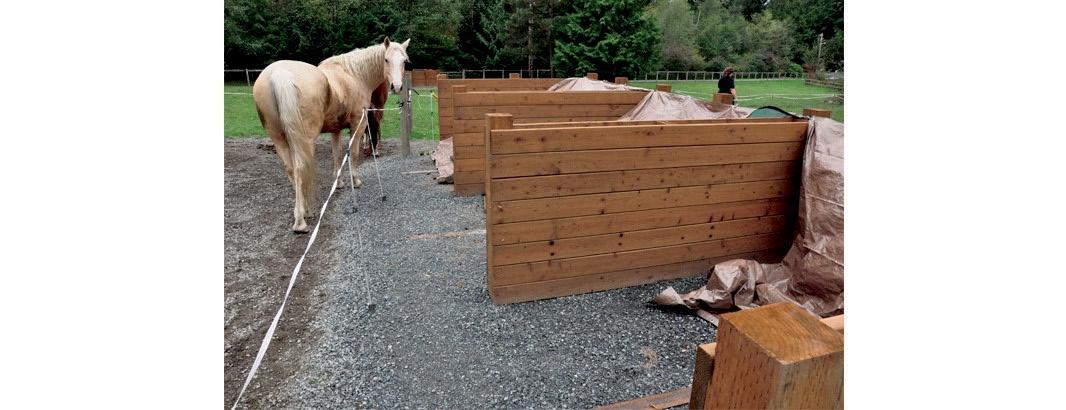










• This zero-tail-swing excavator provides unrestricted rotation, giving operators more room to work in close proximity to walls and other objects.
• The 3-ton compact excavator market is highly competitive with a high retail volume. R2-Series compact excavators are designed to excel in this marketplace by providing the performance, durability, quality and versatility necessary to push operator productivity and profitability to the next level.
• Lease for as low as $765 per month


I am absolutely thrilled to share the outstanding success of the NJLCA’s 38th Annual Landscape New Jersey 2025 trade show! Held on February 26, 2025, at the Meadowlands Expo Center in Secaucus, NJ, this premier industry event once again brought together an incredible 2,000+ landscape professionals for an exciting day filled with education, networking, and industry innovation.

By Gail Woolcott Executive Director

this was our first year using the app and we identified a few areas for improvement, we are confident that in future years, it will make participation seamless and more efficient.
A Celebration of Education, Innovation & Industry Growth
Beyond the bustling trade show floor, 18 top-notch educational seminars and workshops provided attendees with invaluable insights
Another highlight of the event was our 10th annual Silent Auction, an initiative that directly supports scholarships for students in the industry as well as the families of NJLCA members. This year’s auction raised several thousand dollars for the NJLCA Education Fund, ensuring that future generations of landscape
already looking forward to our next major event—The New Jersey Contractors Showcase Expo, taking place this August at County College of Morris. This one-day outdoor show offers attendees the unique opportunity to test drive and experience equipment firsthand, making it a must-attend event for industry professionals looking to explore new tools and machinery. I encourage all landscape professionals and outdoor living industry businesses to stay connected and informed by becoming an NJLCA member. Visit www.njlca.org for updates on upcoming events, industry news, and exclusive member benefits.
A huge thank you to everyone who made Landscape New Jersey 2025 such an overwhelming success—we can’t wait to see you again next year!
The event was a hub for professionals from all sectors of the green industry, including landscapers, hardscapers, turf professionals, nurseries, sod producers, greenhouse operators, municipal employees, and students, all eager to explore the latest advancements, trends, and business opportunities. The energy in the room was truly electric as industry leaders, exhibitors, and attendees engaged in meaningful conversations, forged new connections, and discovered cutting-edge products and services designed to help their businesses grow.
A Sold-Out Show Floor— Once Again!
For the second consecutive year, the trade show floor was completely sold out, and the demand was higher than ever! The Meadowlands Expo Center was packed to capacity with a diverse array of vendors, showcasing everything from heavy equipment, artificial turf, financial services, handheld tools (including a growing selection of electricpowered options), and an extensive range of materials such as mulch, salt, aggregates, stone, pavers, wall block, and so much more. In addition, businesses offering software solutions, apps, and other essential services were on hand to demonstrate how technology continues to revolutionize the landscape industry.
Introducing the NJLCA Buyer’s Guide App!
One of the most exciting additions to this year’s event was the launch of the brand-new NJLCA Buyer’s Guide app! This digital tool provided an interactive version of the traditional printed guide, making it easier than ever for attendees to navigate the show, check off must-visit vendors, access the educational agenda, and learn more about featured speakers. Additionally, a new “scan and go” feature streamlined the class attendance process, allowing participants to digitally sign in and out of sessions, ensuring their license information was automatically updated. While

into the industry’s hottest topics. From sustainable landscaping practices to the latest advancements in equipment, technology, and business strategies, these sessions were packed with information to help professionals enhance their skills, stay ahead of industry trends, and position their businesses for success.
professionals have the support and resources they need to succeed.
The success of Landscape New Jersey 2025 is a testament to the resilience, innovation, and dedication of the green industry in New Jersey. As we celebrate another incredible show, we are

Editor’s Note: Gail Woolcott is the Executive Director for the New Jersey Landscape Contractors Association. Gail received the New York State Turf & Landscape Association 2022 “Person of the Year” award on December 1, 2022. Gail also received a proclamation from the Westchester County, New York Board of Legislators proclaiming December 1, 2022 as “Gail Woolcott Day” in Westchester County. Gail has also been presented with a community service award from the Borough of Fairview, New Jersey for her assistance in leading the 9-11 Memorial Park project and the Legislative Champion of the Year award from the Federation of Employers and Workers of America. She can be reached at 201-703-3600 or by emailing gwoolcott@ njlca.org.
Early spring is the best time of the year to plant fruit trees here in New Jersey.
When they are planted in the early spring, they have the advantage of having a full growing season to acclimate, grow, and develop before they go into dormancy later in the fall. And because the weather is cooler and the trees are dormant when they are planted, they don’t have that much of a water requirement either. Plus, and this is probably most important, this is when most fruit trees are readily available from commercial nurseries.
But before any ground is disturbed or holes are dug, there are a few items to take care of before any trees are planted. First, it is important to select a good location that is suitable for growing fruit trees. The area should have as much exposure to the sun as possible. It should also be well drained, or at the very least not in a wet area. The next step is to get the soil nutrient levels where they should be. The best way to do this is to get a soil test done so that you can determine what

By Peter Melick Agricultural Producer
soil amendments need to be added. Don’t worry too much about nitrogen. This can be added later on in the spring and summer when the trees start to actively grow. But it is important to work any lime or other nutrients into the root zone before the trees are planted. If you wait until after planting, it can take years for these nutrients to work their way down to the root zone. Once you have your trees, you should wait until the soil is dry enough to plant. The soil should not be muddy or clumpy. It should flow evenly off the shovel. This way, it will form a nice environment for the roots. If the soil is too wet, air pockets will remain and will cause the roots to
dry out. Also, if there is clay in the soil and it is too wet, it will later dry, harden, and act like a clay pot, which will really retard root growth. A good rule of thumb is once you think it is dry enough, wait one more day. You can always water the trees after they are planted. When planting the trees, it is important to get the depth of the trees at the correct level. The bud union is where the rootstock (bottom) joins the scion, or variety (top). After the tree is planted, this bud union should be just above the soil line. If it is planted too deeply, the scion will start rooting itself and that will negate the ability of the rootstock to regulate the size
of the tree. It is also important to face the bud union away from the prevailing wind. By planting the tree into the wind, the tree will be much less likely to blow over or break during windy conditions.
After the trees have been planted for a few days, if there has not been any substantial rain, you should water the trees. This watering will, besides providing water for the tree, settle the dirt around the roots. Be careful not to overwater the tree however, as too much water is worse than not enough water. Then keep an eye on the trees and provide water only if it is absolutely needed, until you start to see some green foliage growing.
It is important to protect the trees from wildlife damage. Rabbits, groundhogs, and deer are the main pests, and the trees should either be fenced or individually caged. This should be done immediately after planting. There also needs to be a plan for weed control as grass and weeds will grow faster than the trees. It is also a good idea to protect the trunk of the tree from mice as well as the occasional errant lawnmower or weed whacker. Then in a couple of years, you’ll be ready for harvest!
Editor’s Note: Peter Melick is co-owner of Melick’s Town Farm in Oldwick and a 10th-generation New Jersey farmer. Peter is Mayor of Tewksbury Township, Hunterdon County, NJ. He also served as a director for the New Jersey Farm Bureau and is a past president of the New Jersey State Board of Agriculture. Peter has also been featured on NJN, News 12 New Jersey and on the Fox Business Network.





Fire Safety Director Richard J. Mikutsky.
“Multiple warning notices about how and why mulch can become a serious fire hazard have been sent to fire officials across the state,” said Lou Kilmer, CPM, chief of the Division’s Bureau of Fire Code Enforcement. “Wood-based mulch is combustible and may be challenging to extinguish once it ignites. Fires can often smolder undetected for a period of time, leading to delayed responses, which can cause them to grow larger and cause more damage if left unchecked. That is why it is essential to maintain safety precautions to prevent a fire outbreak.”
N.J.A.C. 5:70-3, 305.6 Landscape Materials
The use of combustible landscape materials, such as wood-based mulch products, is prohibited in any of the following conditions:
1. Within 18 inches of any building or structure;
2. Within 18 inches of a deck, porch, balcony, or any other portion of the building constructed of combustible material; or
3. Within 18 inches of any designated smoking area defined in Section 310.2.
Exceptions:
1. Live plant material such as shrubs, flowers and trees provided that they are not beneath a
(Continued from page 1)
combustible overhang with less than 6 feet of clearance.
2. Non-combustible building or structure exteriors that have no combustible components or trim with less than 3 feet clearance from grade.
3. Most townhomes that are classified as R3, R4 & R5.
4. Buildings made of noncombustible material, such as warehouses.
5. Fire-resistant mulch.
N.J.A.C. 5:70-3, 305.7 Existing Materials
All occupancies subject to this code shall remove all combustible landscape materials that are located within 18 inches of the foundation of any building or structure or in the area of any designated smoking area. This product may be replaced with noncombustible materials such as stone or sand.
Please take into consideration that landscape fabric can burn or melt under high heat or flame.
All property owners are encouraged to follow these guidelines to enhance fire safety.
The mission of the New Jersey Division of Fire Safety shall be to serve as the central focus for the State’s fire service community and the general public in all matters relating to fire safety through the development and enforcement of the New Jersey
Uniform Fire Code (NJUFC), public education programs and firefighter training programs. Within the Division of Fire Safety, the Bureau of Fire Code Enforcement is responsible for enforcing the NJUFC.
Local fire officials also have the responsibility and authority to enter, investigate and perform routine fire inspections of all buildings, structures, and properties with the exception of owneroccupied detached one and two-family dwellings used exclusively for dwelling purposes as required by the NJUFC. All commercial properties, business and apartment-multi dwellings must be inspected yearly.
Editor’s Note: Tom Castronovo is executive editor and publisher of Gardener News. Tom’s lifelong interest in gardening and passion for agriculture, environmental stewardship, gardening, and landscaping, led to the founding of the Gardener News, which germinated in April 2003 and continues to bloom today. He is also dedicated to providing inspiration and education to the agricultural, gardening, landscaping, nursery, and outdoor living communities through this newspaper and GardenerNews.com.


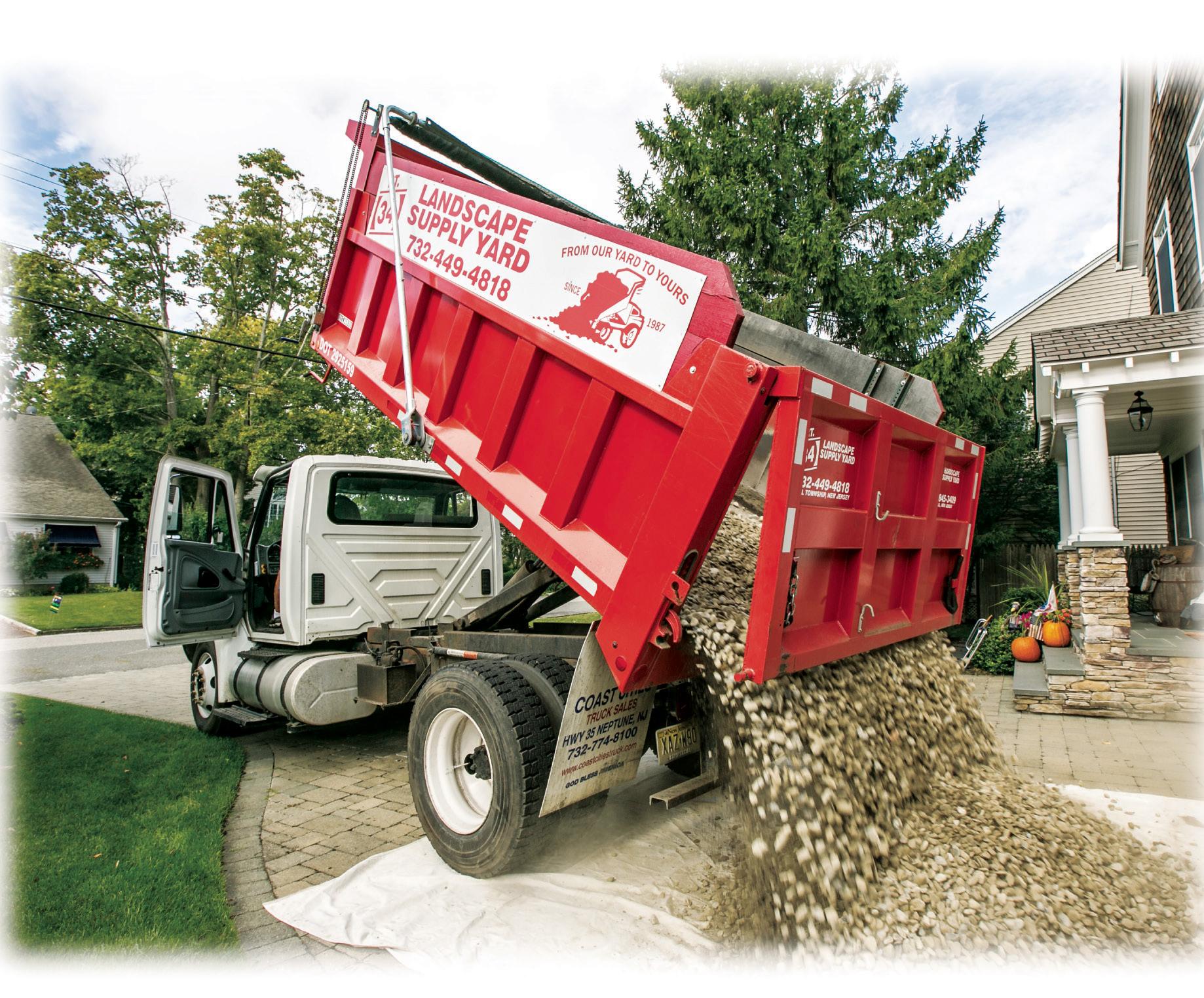





New and Novice gardeners who started gardening in the past four years will keep gardening in 2025; however, fewer will increase their garden spending and time in the coming year according to a newly release report from Axiom.
Axiom recruited 300 new gardeners who’ve gardened four years or less, who own a home and who purchased a garden plant in 2024. Of these respondents 35.2% are first time gardeners, and 64.8% have gardened 2-4 years. Three-quarters (75.8%) characterize themselves as casual gardeners. More than three-quarters of respondents live in urban or suburban environments in the United States.
“This is the first year since we launched the Axiom Gardening Outlook Study that we’ve observed decreases in time spent gardening and plans to plant more and expand their gardens,” says Mike Reiber, founder and CEO of Axiom. “These decreases indicate a potential levelling that merits further investigation. Despite these decreases, however, four in 10 respondents say they plan to spend more money on gardening in 2025 and plan to spend more time gardening in 2025.”
New and novice gardeners will keep gardening in 2025; however, fewer will increase their garden spending and time spent gardening
• 70% felt successful or highly successful in their garden activities in 2024. 82.1% were satisfied with the quality of their flowers and vegetables.
• 54.6% will spend the same amount of money in 2025 as they did in 2024. 34.8% plan to spend more in 2025 -- a decrease of 13.5 percentage points from last year.
• 47.1% will spend the same amount of time in 2025 as they did in 2024. 42.3% plan to spend more time in 2025 -- a decrease of 9.8 percentage points from last year.
• 38.3% will plant the same amount – an increase of 17.3 percentage points from last year. 50.7% will plant more and expand their gardens – a decrease of 19 percentage points from last year.
New and novice gardeners know the plants they want and will drive to find them; however, fewer will pay more to purchase them.
• 42.7% visited other retailers to find the varieties of plants they wanted to buy in 2024 – an increase of 7.1 percentage points from last year.
• 22.7% searched the internet – a decrease of 5 percentage points from last year.
• 74% will drive 6-10 miles to find the plants they want.
• 38.3% are unwilling to pay more for the specific color of flower or variety of
The U.S. Department of Agriculture’s National Agricultural Statistics Service (NASS) will continue to collect the 2024 Census of Horticultural Specialties through April 18, 2025. Conducted just once every five years, the Census of Horticultural Specialties is the only source of detailed production and sales data for U.S. floriculture, nursery, and specialty crop industries, including greenhouse food crops.
Growers are encouraged to complete their survey either online at agcounts. usda.gov or by mail as soon as possible. The online questionnaire is user friendly, accessible on most electronic devices, and saves producers time by calculating totals and automatically skipping questions that do not apply to their operations.
NASS enumerators will also continue gathering data and ask that respondents complete and return their survey form as soon as possible. If those who have received the form are no longer involved in horticultural operations, or need assistance completing the questionnaire, they can call toll free at 888-424-7828 so their record can be updated.
Producers who receive the 2024 Census of Horticultural Specialties are required to respond by federal law (Title 7 USC 2204(g) Public Law 105-113), as it is part of the Census of Agriculture program. That same law also requires NASS to keep all individual information confidential.
The 2024 Census of Horticultural Specialties data is scheduled to be available on December 16, 2025
vegetable plant – an increase of 12.8 percentage points from last year.
• 61.7% are likely to pay more for the specific color of flower or variety of plant they want -- a decrease of 12.8 percentage points from last year.
New and novice gardeners value varieties that with lots of blooms and produce, which are easy to grow; however, price increasingly important compared to brand.
• Plants that produce lots of blooms, fruits and vegetables and are easy to grow top two most important purchase characteristics.
• Top three factors in plant purchase decisions include: Specific variety of plant (32.6%), National brand (14.5%), and Price (12.3%.)
Preferred Retailers and Social Media
• Top four garden supply outlets include: Home Depot (33.5%), Lowe’s (19.4%), Walmart (16.7%) and IGCs (9.7%.)
• Top four plant purchase outlets include: Home Depot (33%), Lowe’s (18.1%), IGCs (13.4%), and Walmart (13%.)
• Top four purchase sites for seeds to grow into plants include: Home Depot (22%), Walmart (15.4%0, Lowe’s (15.4%), IGCs (11.5%.)
• Lowe’s garden supply and plant purchases decreased from 7.2 and 8.5 percentage points from last year.
• 11.3% will buy what store associates suggest as substitutes – a decrease of 10.1 percentage points from last year.
• YouTube most important social media to learn about new plants and gardening supplies – similar to last year.
New and novice gardeners less interested in plants that are organically and locally grown and in starting seeds.
• Importance of organically and locally grown plants has decreased 18.8 and 15.5 percentage points, respectively, from last year.
• Buying seed to grow plants has decreased 22 percentage points from last year.
• Planting seeds to save money has decreased 9.4 percentage points from last year.
Axiom is a market strategy consulting company founded in 1993.
They provide market research, channel strategy, new product development and marketing communication services to Fortune 500 manufacturers and service providers in agriculture, horticulture, building products and energy.
All licensed pesticide applicators, as well as dealers, who store pesticides are required by law to send a copy of their storage inventor(ies) with an explanatory cover letter to the local fire company by May 1st each year. In New Jersey, all licensed pesticide applicators and dealers who store pesticides are required per N.J.A.C. 7:309.5 to maintain a list of the pesticides stored, or likely to be stored, during the license year. A storage inventory should be kept separate from the actual storage area.
New Jersey regulations also specifically require a written description or diagram depicting the exact location of the area on the property where the pesticide is stored. This does not pertain to pesticides stored for personal use, or to those storing pesticides at loading or application areas for less than 7 days.
Applicators and dealers must keep the cover letter on file for a minimum of three years and should have it available for NJDEP upon request.
Learn more at https://pestmanagement.rutgers.edu/pesticide-applicator-or-dealerstorage-inventory-with-cover-letter-due-may-1st-to-fire-department/
















































































































































































































































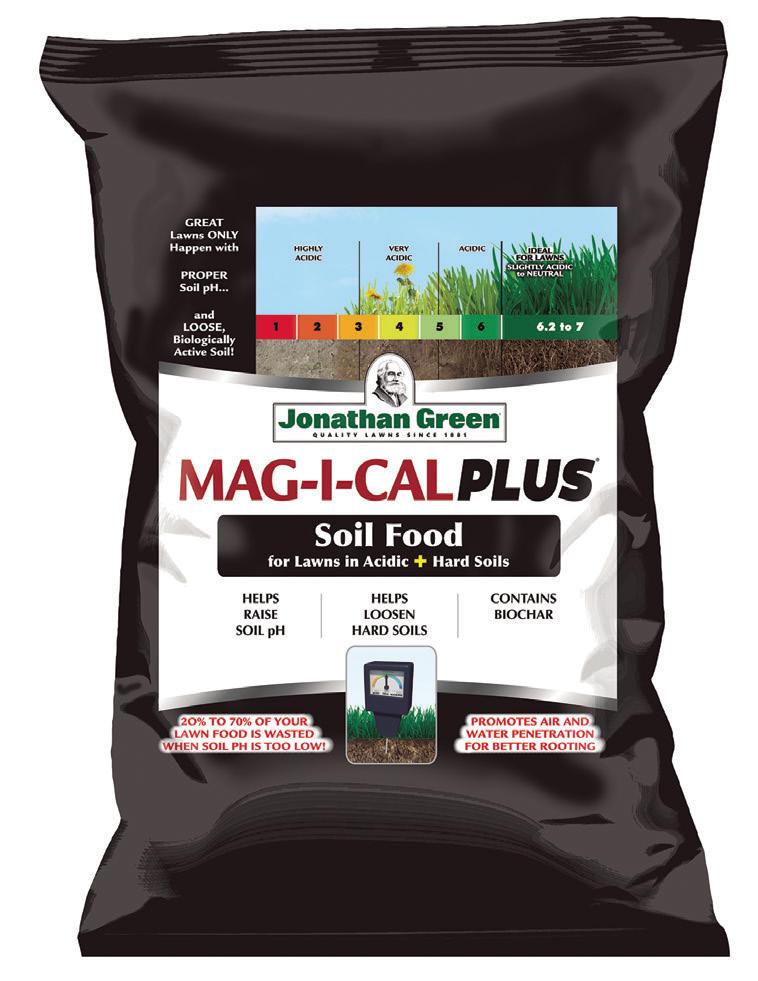









The Northeastern Association of State Departments of Agriculture convenes the following 10 states: Connecticut, Delaware, Maine, Massachusetts, New Hampshire, New Jersey, New York, Pennsylvania, Rhode Island, and Vermont.
The New York State Department of Agriculture and Markets (AGM) today reminded eligible farmers that registration is now open for New York’s 2025 Farm Employer Overtime Credit Advance program. The Farm Employer Overtime Credit is a refundable tax credit available for eligible farm employers who pay overtime wages based on the gradual phase-in of the overtime threshold in New York State. Farmers are encouraged to begin recordkeeping for the January 1 through July 31 2025 timeframe to apply for reimbursement later this year. The Farm Employer Overtime
Credit program was first announced in the Governor’s 2022 State of the State to help farmers meet the challenge of farm labor costs.
State Agriculture Commissioner Richard A. Ball said, “The State is once again ready to roll out the Farm Employer Overtime Credit Advance to provide farmers with the resources they need to support their workforce and meet their food production goals. Last year, in coordination with the Department of Tax and Finance, we were able to provide timely cash flow assistance to farmers across the State through the overtime advance program and it is
our hope that, this year, even more farmers look at the resources we have available, learn more about the Farm Employer Overtime Credit Advance program, and take part in this great opportunity.”
Farmers can apply for this refundable credit if they or their business are an eligible farmer and they employ eligible farm employees that were paid eligible overtime.
Learn more at https://agriculture.ny.gov/ news/state-department-agriculture-remindseligible-farmers-registration-open-new-yorks2025-farm







The New Jersey Department of Agriculture is now accepting applications for 2025 United States Department of Agriculture Specialty Crop Block Grants.
Specialty crops include fruits, vegetables, tree nuts, horticulture, nursery crops and floriculture. Most of New Jersey agriculture falls under the specialty crop category. This USDA grant is for agricultural organizations that represent multiple producers.
“Many producers in New Jersey fall under the specialty crop designation and have used this grant opportunity for financial assistance with marketing initiatives,” NJDA Secretary Ed Wengryn said. “In an effort to be proactive, we are issuing the RFP now, before our producers get caught up in the planting and early harvest season, and we encourage anyone interested to apply for
these federal funds.”
To be eligible for a grant, projects must “enhance the competitiveness” of specialty crops and might include, but are not limited to: research, promotion, marketing, nutrition, trade enhancement, food safety, food security, plant health programs, education, “buy local” programs, increased consumption, increased innovation, improved efficiency and reduced costs of distribution systems, environmental concerns and conservation, product development and developing cooperatives.
Download the application at www.nj.gov/ agriculture/grants/specialtycropblockgrants. html. The deadline for submitting applications is 5 p.m., April 10, 2025. Publishing this request for proposals (RFP) does not commit the state to awarding any federal funds.
The Vermont Agency of Agriculture, Food and Markets (VAAFM) announces the availability of grant funds to expand farm to school and early childhood programming in Vermont. The Farm to School and Early Childhood Vision Grant supports projects that amplify innovative work in individual school communities, strengthen farm to school support services, and reach underserved school and early childhood communities.
Schools, school districts, early childhood educators, afterschool programs, and nonprofits working in partnership with other organizations in the Vermont Farm to School and Early Childhood Network, are eligible to apply. $275,000 is available to award and the min/max award range is $10,000 - $60,000.
The purpose of the Vermont Farm to School and Early Childhood Program is to help Vermont schools and early childhood programs develop farm-to-school programs that will sustain relationships with local farmers and producers, enrich the educational experience of students, improve the health of Vermont children, and enhance Vermont’s agricultural economy. The Vermont Farm to School and Early Childhood Program was authorized by the Vermont State Legislature in 2006 with the enactment of the Rozo Mclaughlin Farm-to-School Program Act (6 V.S.A. § 4721).
Applications are due Thursday, April 10 at 2:00 PM. Interested applicants can learn more at agriculture.vermont.gov/farmtoschool.
The Connecticut Milk Promotion Board (CTMPB), administered by the Connecticut Department of Agriculture, is pleased to announce up to $700,000 available in funding opportunities for programming in fiscal years 2026 and 2027. These opportunities align with their core focus which includes the vision of increasing purchases and expanding the access of milk and dairy products to consumers, retailers, institutions, and other applicable outlets. The funding is intended to support the CTMPB’s mission to develop, coordinate, and implement promotional, research, and other programs designed to promote Connecticut dairy farms and the consumption of milk and dairy products.
Eligible applicants can apply for any combination of the above program areas and are not limited to applying for only one. Qualified entities include businesses, extension agencies, agricultural and non-profit organizations, universities, community colleges, educational institutions, agricultural science schools, research organizations, and contract media vendors. Interested applicants should review each funding guidance document to confirm their eligibility.
Funding is provided through dairy checkoff dollars, established through the national dairy checkoff order. CGS Sec. 22-authorizes the CTMPB to award grant funds from Connecticut’s portion of checkoff dollars. All projects should be conducted in accordance with the national dairy checkoff order, which can be found at: httpst//www.ams.usda.gov/ rules-regulations/research-promotion/dairy.
Additional details on the dairy grant funding opportunities can be found on www.CTGrown. gov. For more information on Connecticut Milk Promotion Board and Connecticut Dairy, visit CTDairy.org.
The New Jersey State Agriculture Development Committee (SADC) appointed Charles “Chuck” Roohr as its new Executive Director during a special SADC meeting on Wednesday, February 12.
Chuck has been with the SADC since 2000 and has worked extensively in all aspects of the Farmland Preservation Program (FPP), including the Right to Farm program, acquiring easements and purchasing and reselling farms in fee simple, and stewardship of preserved farmland. Chuck has also led the effort to develop the SADC’s new “Statewide Formula Value,” an alternative method to value farmland other than traditional appraisals by taking into account other attributes such as soil quality, size, proximity to preserved land, natural resources, and the rate of inflation.
Since 2019, Chuck has been the SADC’s Chief of Agriculture Resources, responsible for managing all post-preservation aspects of preserved farmland, including applications for solar installations, agricultural labor housing, house replacement, and division of preserved farms. He has also led the development and implementation of programs to support New Jersey’s agricultural businesses, including deer fencing, soil and water cost-share grants, and the SADC’s one-time “business development” grant program. In 2022, he was also named the SADC Deputy Executive Director, and since June 2024, he has covered the SADC’s Executive Director responsibilities after long-time executive director Susan Payne retired.
Chuck was born and raised on
his family’s Central Jersey farm, which specializes in vegetables, fruit, grain, and pheasants. His first-hand knowledge of the challenges of operating a farm in New Jersey, coupled with his over two decades of work within the SADC, uniquely positions him to lead the agency’s future. He has continued to farm nights and weekends actively throughout his professional career.
“Chuck’s program experience, excellent customer service skills, farming background, and ability to communicate effectively with the agricultural community and government agencies alike make him an ideal candidate for the position of Executive Director,” said New Jersey Secretary of Agriculture and Chairman of the State Agriculture Development Committee, Ed Wengryn. “As we
look to the future of the preservation program and emphasize farm viability, Chuck has working knowledge on how best to not only sustainably manage the land, but find opportunities to build and sustain the business of agriculture here in the Garden State.”
The New Jersey State Agriculture Development Committee (SADC) administers New Jersey’s Farmland Preservation Program, Right to Farm, Agricultural Mediation, and Agricultural Development grants to preserved farm owners and operators.
To date, 2,890 farms covering 252,979 acres have been preserved under the New Jersey State Farmland Preservation Program. To learn more about preservation and the SADC, visit: https:// www.nj.gov/agriculture/sadc/ farmpreserve/.
April




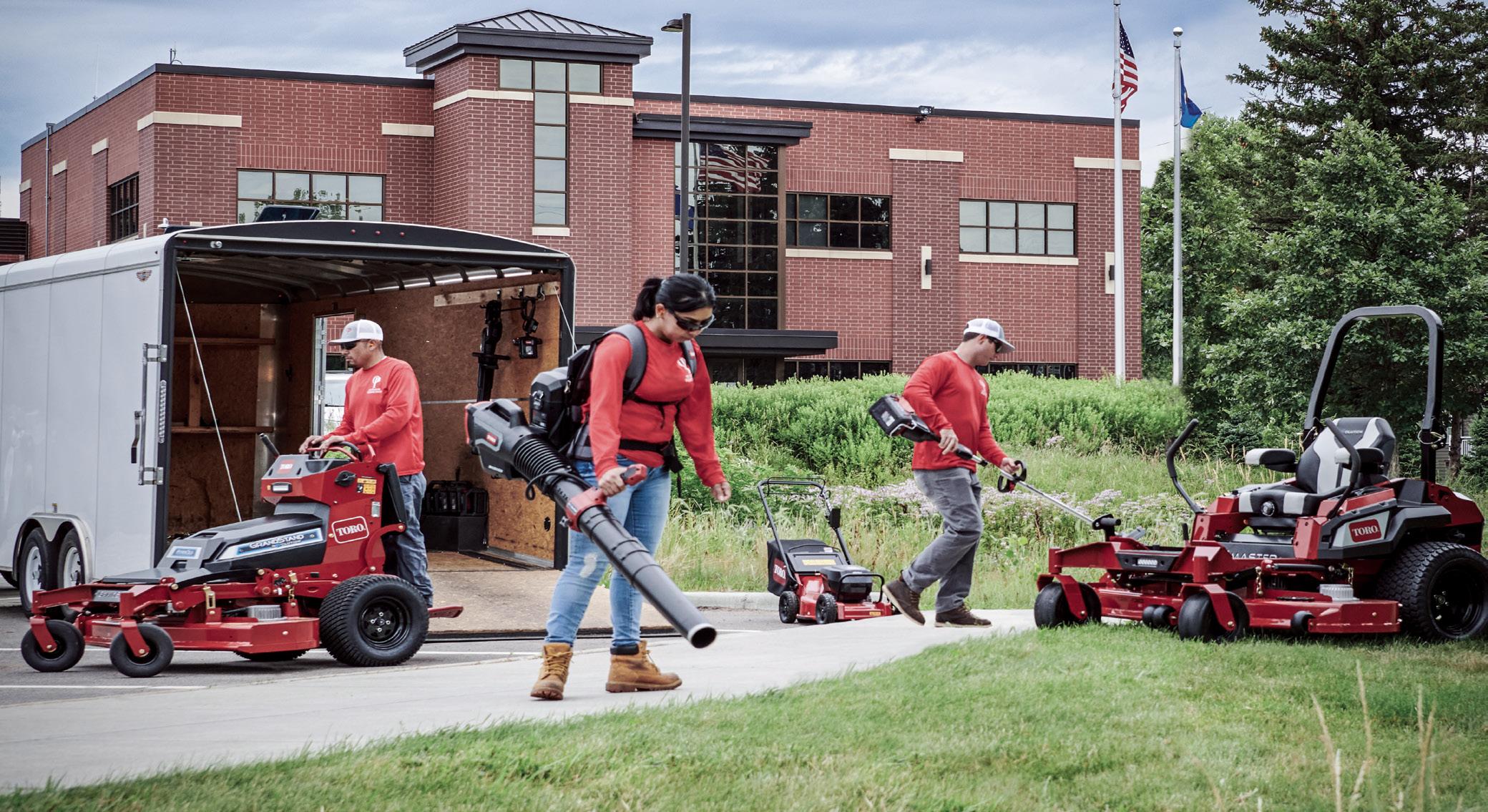





7500-G SERIES ZERO-TURN
96” TURBO FORCE ® CUTTING DECKS
PRODUCTIVITY TO A NEW LEVEL
Impressive 96” wide cutting deck folds to 75” to fit in
ALL DAY PERFORMANCE
The fully interchangeable 60V Max*
Flex-Force battery system powers the entire line of Revolution commercial grade handheld tools. The backpack, available as a power source for the leaf blower, string and hedge trimmers, and is built for comfort and ready to keep jobs moving all day.
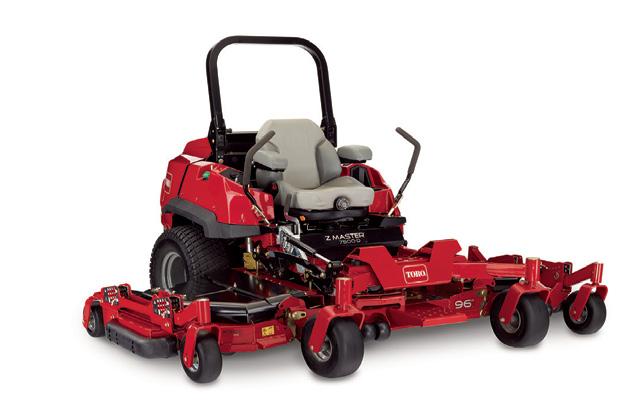
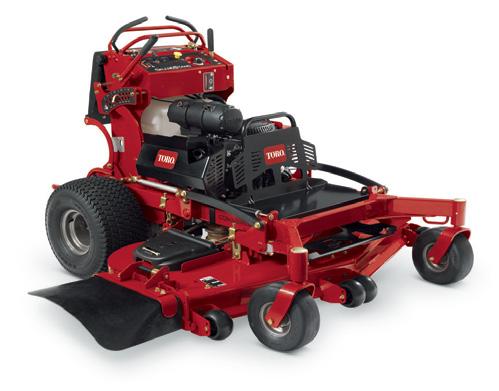
STAND-ON MOWERS
TRACTION & HANDLING
A wide stance and optimal balance enhance hillside stability and control.
CUSHIONED SUSPENSION
Flex-Ride operator platform suspension self-compensates for operators of all sizes, resulting in less fatigue and higher productivity throughout the day.

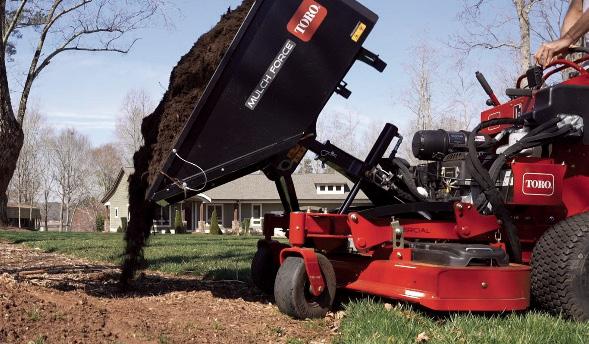

Dual
Provide
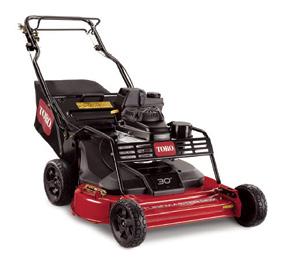
A variety of attachments and accessories such as Mulch Dump, Pro-Force blower, snow thrower, power broom, tine rake, dethatcher and BOSS snow blade all provide the ultimate in productivity.
